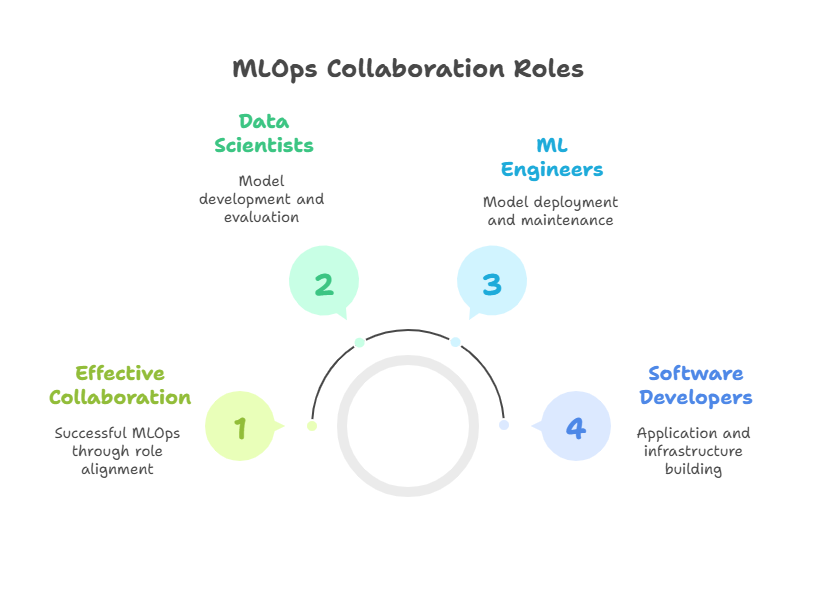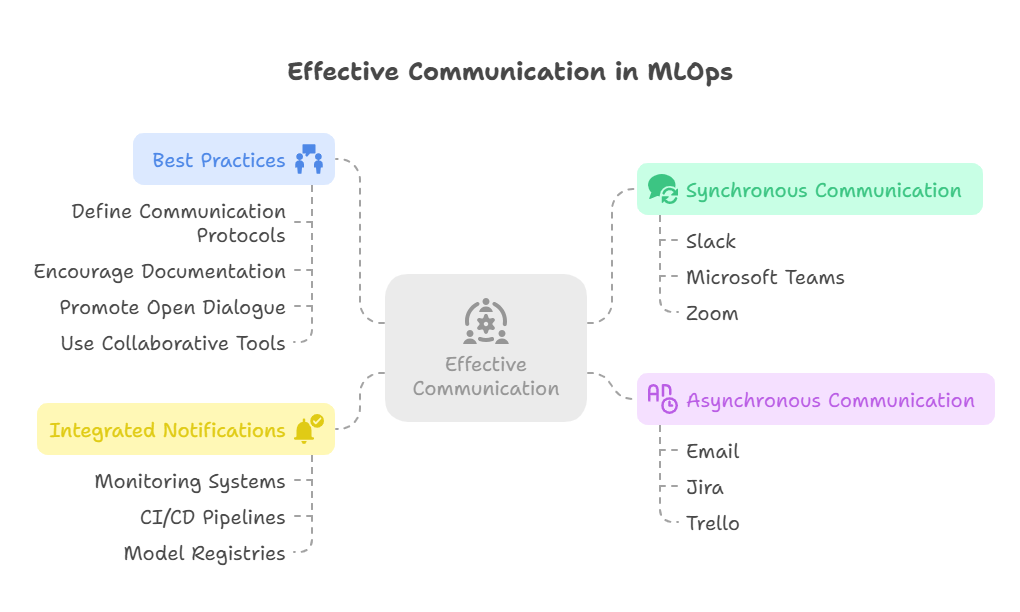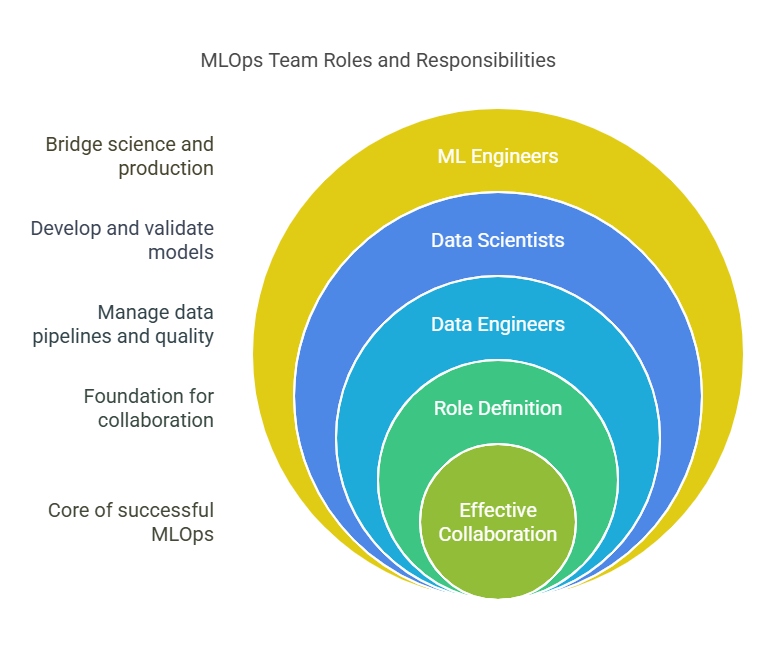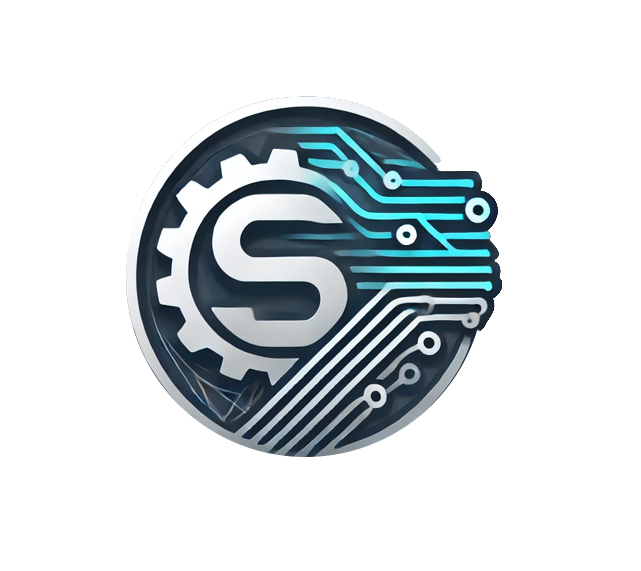Introduction: The Importance of Collaboration in MLOps
In the rapidly evolving field of machine learning operations (MLOps), collaboration between diverse teams is more critical than ever. Successful deployment and maintenance of machine learning models require the combined efforts of data scientists, ML engineers, software developers, and operations teams. Without effective collaboration, projects can suffer from miscommunication, duplicated work, and delays, ultimately impacting the quality and reliability of AI solutions.
MLOps is inherently interdisciplinary, bridging the gap between research and production. Data scientists focus on model development and experimentation, while developers and engineers handle deployment, scaling, and integration with existing systems. Operations teams ensure infrastructure stability and monitor model performance in production. Each group brings unique expertise, but their work is deeply interconnected.
Effective collaboration fosters transparency, accelerates problem-solving, and ensures that models meet both technical and business requirements. It enables teams to share knowledge, align on goals, and respond quickly to issues such as data drift or model degradation. Moreover, collaboration supports compliance and auditability by maintaining clear documentation and traceability throughout the ML lifecycle.
In this context, developers play a pivotal role as connectors and enablers. By adopting collaborative tools, establishing clear communication channels, and embracing shared workflows, developers can help break down silos and create a unified MLOps culture.
In summary, collaboration is the foundation of successful MLOps. It transforms isolated efforts into cohesive, efficient workflows that deliver reliable, scalable, and impactful machine learning solutions. As AI continues to shape industries, fostering strong collaboration among teams will be a key differentiator for organizations striving to lead in the AI era.
Understanding the Roles: Data Scientists, ML Engineers, and Developers
Effective collaboration in MLOps begins with a clear understanding of the distinct roles and responsibilities of the key players involved: data scientists, machine learning (ML) engineers, and software developers. Each role brings unique skills and perspectives that, when aligned, drive the successful development, deployment, and maintenance of machine learning models.
Data Scientists
Data scientists focus primarily on exploring data, developing models, and conducting experiments. Their expertise lies in statistical analysis, feature engineering, algorithm selection, and model evaluation. They work to create models that deliver accurate predictions and insights, often using notebooks and specialized ML frameworks. Data scientists are responsible for understanding the business problem and translating it into a machine learning task.
ML Engineers
ML engineers bridge the gap between data science and production systems. They take models developed by data scientists and build scalable, reliable pipelines for training, validation, deployment, and monitoring. Their work involves software engineering best practices, containerization, orchestration, and automation. ML engineers ensure that models can be integrated into production environments and maintained over time.
Software Developers
Software developers focus on building the applications and infrastructure that consume ML models. They design APIs, user interfaces, and backend systems that leverage model predictions to deliver business value. Developers also collaborate with ML engineers to embed models into larger software ecosystems, ensuring performance, security, and scalability.
Overlap and Collaboration
While these roles have distinct focuses, their responsibilities often overlap. For example, data scientists may need to understand deployment constraints, ML engineers may contribute to feature engineering, and developers may assist with monitoring and logging. Recognizing these overlaps fosters better communication and shared ownership.

Common Collaboration Challenges in MLOps
While collaboration is essential for successful MLOps, teams often face several common challenges that can hinder productivity, slow down deployments, and impact model quality. Recognizing these obstacles is the first step toward building effective strategies to overcome them.
- Siloed Teams and Communication Gaps
Data scientists, ML engineers, and software developers often work in separate teams with different tools, languages, and workflows. This separation can lead to misunderstandings, duplicated efforts, and delays in integrating models into production.
- Inconsistent Tooling and Processes
Using disparate tools for experiment tracking, version control, deployment, and monitoring creates friction. Without standardized platforms or integration, sharing results and coordinating workflows becomes cumbersome.
- Lack of Clear Roles and Responsibilities
Ambiguity about who owns which part of the ML lifecycle—data preparation, model training, deployment, or monitoring—can cause bottlenecks and accountability issues.
- Data and Model Versioning Conflicts
Without unified versioning systems, teams may struggle to track which data and model versions correspond, leading to reproducibility problems and deployment errors.
- Difficulty in Managing Dependencies and Environments
ML projects often involve complex dependencies across libraries, frameworks, and hardware. Inconsistent environments can cause models to behave differently in development and production.
- Limited Visibility and Monitoring
Lack of shared dashboards and real-time monitoring hampers the ability to detect issues early and coordinate responses across teams.
- Cultural and Organizational Barriers
Differences in team priorities, communication styles, and incentives can impede collaboration and knowledge sharing.
Establishing Clear Communication Channels
Effective communication is the backbone of successful collaboration in MLOps. Establishing clear, consistent, and accessible communication channels helps bridge the gaps between data scientists, ML engineers, software developers, and business stakeholders. It ensures that everyone stays aligned, informed, and able to respond quickly to challenges or changes.
Why Clear Communication Channels Matter
MLOps projects involve complex workflows and diverse teams with different expertise and priorities. Without structured communication, misunderstandings can arise, leading to delays, duplicated work, or misaligned objectives. Clear channels facilitate knowledge sharing, decision-making, and rapid problem resolution.
Types of Communication Channels
Synchronous Communication:
Tools like Slack, Microsoft Teams, or Zoom enable real-time discussions, quick clarifications, and collaborative problem-solving. Regular stand-ups and cross-team meetings foster alignment.
Asynchronous Communication:
Email, project management platforms (e.g., Jira, Trello), and shared documentation (e.g., Confluence, Notion) allow teams to communicate across time zones and maintain records of decisions and action items.
Integrated Notifications:
Connecting monitoring systems, CI/CD pipelines, and model registries to communication platforms ensures that alerts, deployment statuses, and experiment results are promptly shared with relevant teams.
Best Practices for Communication
Define Communication Protocols: Establish guidelines on when and how to use different channels to avoid noise and ensure important messages are seen.
Encourage Documentation: Maintain up-to-date, accessible documentation of workflows, models, and decisions to support onboarding and knowledge transfer.
Promote Open Dialogue: Foster a culture where team members feel comfortable sharing ideas, asking questions, and raising concerns.
Use Collaborative Tools: Leverage shared platforms that integrate with development and monitoring tools to centralize information.

Shared Tools and Platforms for Seamless Collaboration
In the complex landscape of MLOps, relying on a patchwork of disconnected tools can severely hinder collaboration and efficiency. The future of successful MLOps lies in adopting shared tools and integrated platforms that provide a unified environment for data scientists, ML engineers, and software developers. This approach breaks down silos, streamlines workflows, and ensures seamless communication and coordination across the entire machine learning lifecycle.
Why Shared Tools Are Crucial
When different teams use disparate tools for experiment tracking, code versioning, data management, and deployment, it creates friction at every handoff. Data scientists might use one system for experiments, while engineers use another for production deployment, leading to manual data transfers, inconsistent metadata, and difficulties in reproducing results. Shared tools eliminate these inefficiencies by providing a common language and a single source of truth for all aspects of an ML project.
Key Categories of Shared Tools and Platforms
Experiment Tracking and Model Registry: Platforms like MLflow, Weights & Biases, or Neptune.ai allow data scientists to log parameters, metrics, and artifacts, while ML engineers can use the same platform to register, version, and manage models for deployment. This ensures that everyone has visibility into experiment results and model lineage.
Version Control Systems: Git (and platforms like GitHub, GitLab, Bitbucket) is fundamental for versioning code. For data and model artifacts, tools like DVC (Data Version Control) or LakeFS extend Git-like versioning capabilities to large files, ensuring that data scientists and engineers are always working with the correct versions of data and models.
Workflow Orchestration: Tools such as Apache Airflow, Kubeflow Pipelines, or Prefect provide a unified way to define, schedule, and monitor complex ML pipelines. Both data engineers (for data pipelines) and ML engineers (for training and deployment pipelines) can use the same orchestrator, making dependencies clear and enabling end-to-end automation.
Feature Stores: Centralized feature stores (e.g., Feast) serve as a shared repository for curated features. Data engineers can publish features, and data scientists can consume them for training, while ML engineers can serve them for real-time inference, ensuring consistency and reusability.
Monitoring and Observability Platforms: Unified dashboards (e.g., Grafana, Kibana, or cloud-native monitoring services) provide real-time insights into both data pipeline health and model performance. This shared visibility allows all teams to quickly detect issues, understand root causes, and coordinate incident response.
Communication and Documentation: Integrated communication platforms (e.g., Slack, Microsoft Teams) with automated notifications from MLOps tools, combined with shared documentation platforms (e.g., Confluence, Notion), ensure that information flows freely and decisions are recorded.
Benefits of Adopting Shared Tools
Reduced Friction: Seamless handoffs and fewer manual steps.
Improved Reproducibility: Consistent environments and versioning across the lifecycle.
Enhanced Transparency: Everyone has visibility into project status, experiments, and deployments.
Accelerated Development: Faster iteration and deployment cycles.
Better Collaboration: Fosters a common language and shared understanding among diverse teams.
Version Control and Experiment Tracking Best Practices
Effective version control and experiment tracking are foundational to successful MLOps workflows. They ensure reproducibility, facilitate collaboration, and provide transparency throughout the machine learning lifecycle. By adopting best practices in these areas, teams can manage complexity, reduce errors, and accelerate the delivery of high-quality models.
Version Control Best Practices
Use Git for Code:
Track all code changes, including data preprocessing scripts, model training code, and deployment configurations. Use branching strategies (e.g., GitFlow) to manage development and production codebases.
Version Data and Models:
Use tools like DVC (Data Version Control) or MLflow to version datasets and model artifacts alongside code. This ensures that every model version is linked to the exact data and code used for training.
Commit Often and Write Clear Messages:
Frequent commits with descriptive messages improve traceability and make it easier to understand the evolution of the project.
Tag Releases:
Use Git tags to mark stable model versions or production releases, enabling easy rollback and audit.
Experiment Tracking Best Practices
Log All Relevant Metadata:
Capture hyperparameters, training metrics, data versions, environment details, and model artifacts for every experiment.
Use Centralized Tracking Tools:
Platforms like MLflow, Weights & Biases, or Neptune provide dashboards for comparing experiments, visualizing metrics, and managing model versions.
Automate Logging:
Integrate experiment tracking into training scripts to automatically log parameters and results, reducing manual errors.
Organize Experiments:
Use consistent naming conventions, tags, and grouping to keep experiments organized and searchable.
Example: Simple Experiment Tracking with MLflow
python
import mlflow
import mlflow.sklearn
from sklearn.ensemble import RandomForestClassifier
from sklearn.datasets import load_iris
from sklearn.model_selection import train_test_split
from sklearn.metrics import accuracy_score
# Load data
data = load_iris()
X_train, X_test, y_train, y_test = train_test_split(data.data, data.target, random_state=42)
with mlflow.start_run():
# Define and train model
n_estimators = 100
max_depth = 5
model = RandomForestClassifier(n_estimators=n_estimators, max_depth=max_depth, random_state=42)
model.fit(X_train, y_train)
# Predict and evaluate
preds = model.predict(X_test)
accuracy = accuracy_score(y_test, preds)
# Log parameters and metrics
mlflow.log_param("n_estimators", n_estimators)
mlflow.log_param("max_depth", max_depth)
mlflow.log_metric("accuracy", accuracy)
# Log model artifact
mlflow.sklearn.log_model(model, "random_forest_model")
print(f"Logged experiment with accuracy: {accuracy:.4f}")Defining Roles and Responsibilities Clearly
Clear definition of roles and responsibilities is crucial for effective collaboration in MLOps teams. As machine learning projects involve diverse skill sets—from data engineering and model development to deployment and monitoring—establishing who owns each part of the workflow helps prevent confusion, reduce bottlenecks, and ensure accountability.
Why Clear Roles Matter
Without well-defined roles, tasks can be duplicated or neglected, communication can break down, and decision-making can become inefficient. Clear responsibilities enable teams to work in parallel, streamline handoffs, and maintain high-quality standards throughout the ML lifecycle.
Typical Roles in MLOps
Data Engineers: Responsible for building and maintaining data pipelines, ensuring data quality, and managing data infrastructure.
Data Scientists: Focus on model development, experimentation, feature engineering, and validation.
ML Engineers: Bridge data science and production by packaging models, building training and deployment pipelines, and ensuring scalability.
DevOps/Infrastructure Engineers: Manage cloud or on-premises infrastructure, CI/CD pipelines, and monitoring systems.
Product Owners/Business Stakeholders: Define business requirements, prioritize features, and evaluate model impact.
Best Practices for Defining Roles
Document Responsibilities: Clearly outline each role’s scope, deliverables, and decision rights.
Establish Collaboration Protocols: Define how teams communicate, share artifacts, and coordinate workflows.
Use RACI Matrices: Assign who is Responsible, Accountable, Consulted, and Informed for key tasks.
Regularly Review and Adapt: Update roles as projects evolve or teams grow.

Implementing Collaborative CI/CD Pipelines
Implementing collaborative Continuous Integration and Continuous Deployment (CI/CD) pipelines is essential for streamlining machine learning workflows and fostering teamwork across data scientists, ML engineers, and developers. Collaborative CI/CD pipelines automate the process of testing, validating, and deploying models, ensuring that changes are integrated smoothly and delivered reliably to production.
Why Collaborative CI/CD Matters
Machine learning projects involve frequent updates to code, data, and models. Without automated pipelines, integrating these changes can be error-prone and slow, leading to deployment delays and inconsistent model performance. Collaborative CI/CD pipelines enable multiple team members to contribute simultaneously while maintaining quality and traceability.
Key Elements of Collaborative CI/CD Pipelines
Version Control Integration:
Use Git or similar systems to manage code, configuration, and infrastructure as code, enabling seamless collaboration and change tracking.
Automated Testing:
Incorporate unit, integration, and end-to-end tests that validate data preprocessing, model training, and inference components.
Experiment Tracking and Model Registry:
Automatically log experiments and register models during pipeline runs to maintain reproducibility and governance.
Deployment Automation:
Use containerization and orchestration tools (e.g., Docker, Kubernetes) to deploy models consistently across environments.
Monitoring and Feedback Loops:
Integrate monitoring tools to track model performance post-deployment and trigger automated retraining or rollback if necessary.
Best Practices for Collaboration
Define Clear Pipeline Ownership: Assign responsibilities for pipeline maintenance and updates to avoid conflicts.
Use Feature Branches and Pull Requests: Facilitate code reviews and quality checks before merging changes.
Document Pipeline Processes: Maintain clear documentation to onboard new team members and ensure consistency.
Enable Role-Based Access Control: Secure pipeline stages and deployment environments to prevent unauthorized changes.
Cross-Team Monitoring and Incident Response
Cross-team monitoring and incident response are vital components of effective MLOps, ensuring that machine learning systems remain reliable, performant, and aligned with business objectives. As ML workflows span data engineering, model development, deployment, and operations, coordinated monitoring and response across teams enable rapid detection and resolution of issues.
The Importance of Cross-Team Monitoring
Monitoring in MLOps involves tracking data quality, model performance, infrastructure health, and user experience metrics. When these metrics are shared across data scientists, ML engineers, DevOps, and business stakeholders, teams gain a holistic understanding of system behavior. This shared visibility helps identify root causes quickly, whether issues stem from data drift, model degradation, or infrastructure failures.
Incident Response in MLOps
A well-defined incident response process ensures that when anomalies or failures occur, the right teams are alerted promptly and can act efficiently. This includes:
Automated Alerts: Configured to notify relevant personnel based on severity and impact.
Runbooks and Playbooks: Documented procedures guiding teams through common incident scenarios.
Collaboration Tools: Platforms like Slack or Microsoft Teams facilitate real-time communication during incidents.
Post-Incident Reviews: Blameless retrospectives to analyze causes, improve processes, and prevent recurrence.
Best Practices for Cross-Team Coordination
Establish Clear Roles: Define who is responsible for monitoring, triage, and resolution at each stage.
Centralize Monitoring Data: Use unified dashboards that aggregate metrics and logs from all components.
Automate Escalation: Ensure critical alerts escalate appropriately to avoid delays.
Foster a Culture of Transparency: Encourage open communication and knowledge sharing during and after incidents.
Fostering a Culture of Continuous Learning and Feedback
In the fast-evolving field of MLOps, fostering a culture of continuous learning and feedback is essential for sustained success. Machine learning systems are complex and dynamic, requiring teams to constantly adapt, improve, and innovate. A culture that encourages experimentation, knowledge sharing, and constructive feedback helps organizations stay ahead of challenges and deliver high-quality AI solutions.
Why Continuous Learning Matters
Machine learning models can degrade over time due to data drift, changing environments, or evolving business needs. Continuous learning ensures that teams regularly review model performance, update workflows, and incorporate new techniques. It also promotes resilience by encouraging teams to learn from failures and iterate rapidly.
Building Feedback Loops
Effective feedback loops connect monitoring insights, user feedback, and business outcomes back to data scientists and engineers. Automated alerts, performance dashboards, and user reports provide actionable information that drives model retraining, feature updates, or pipeline improvements.
Encouraging Knowledge Sharing
Regular team meetings, code reviews, and documentation practices facilitate the exchange of ideas and lessons learned. Cross-functional collaboration between data scientists, ML engineers, and business stakeholders ensures that diverse perspectives inform AI development.
Supporting Experimentation
A culture that values experimentation empowers teams to test new models, features, and approaches without fear of failure. Providing sandbox environments, automated testing, and clear rollback procedures encourages innovation while maintaining stability.
Case Studies: Successful Team Collaboration in MLOps
Successful collaboration among data scientists, ML engineers, data engineers, and business stakeholders is a key driver of effective MLOps implementations. Real-world case studies illustrate how organizations have fostered cross-functional teamwork to accelerate AI delivery, improve model quality, and maintain operational excellence.
Case Study 1: Global Financial Services Firm
A multinational financial institution faced challenges coordinating between its data science and engineering teams. By adopting a unified MLOps platform with integrated experiment tracking, model registry, and monitoring, they established shared workflows and communication channels. Regular cross-team meetings and joint ownership of pipelines improved transparency and reduced deployment times by 40%. The collaboration also enhanced compliance through better auditability and governance.
Case Study 2: Healthcare Analytics Startup
A healthcare startup integrated data engineering and MLOps teams to deliver predictive models for patient outcomes. They implemented feature stores and automated pipelines that both teams contributed to and maintained. Collaborative dashboards provided real-time insights into data quality and model performance, enabling rapid issue resolution. This partnership accelerated model updates and improved patient care outcomes.
Case Study 3: E-commerce Platform
An e-commerce company fostered collaboration by embedding ML engineers within product teams and establishing clear roles and responsibilities. Using shared version control, CI/CD pipelines, and communication tools, teams worked closely from experimentation to deployment. This approach reduced model deployment errors and increased the frequency of model updates, leading to higher customer engagement and revenue growth.
Lessons Learned
Unified Tools and Processes: Shared platforms reduce friction and improve visibility.
Clear Roles and Communication: Defined responsibilities and open channels foster accountability.
Cross-Functional Collaboration: Involving diverse expertise leads to better solutions.
Continuous Feedback: Regular reviews and monitoring support ongoing improvement.
MLOps for Developers – A Guide to Modern Workflows
From Code to Production: The Best MLOps Tools for Developers

